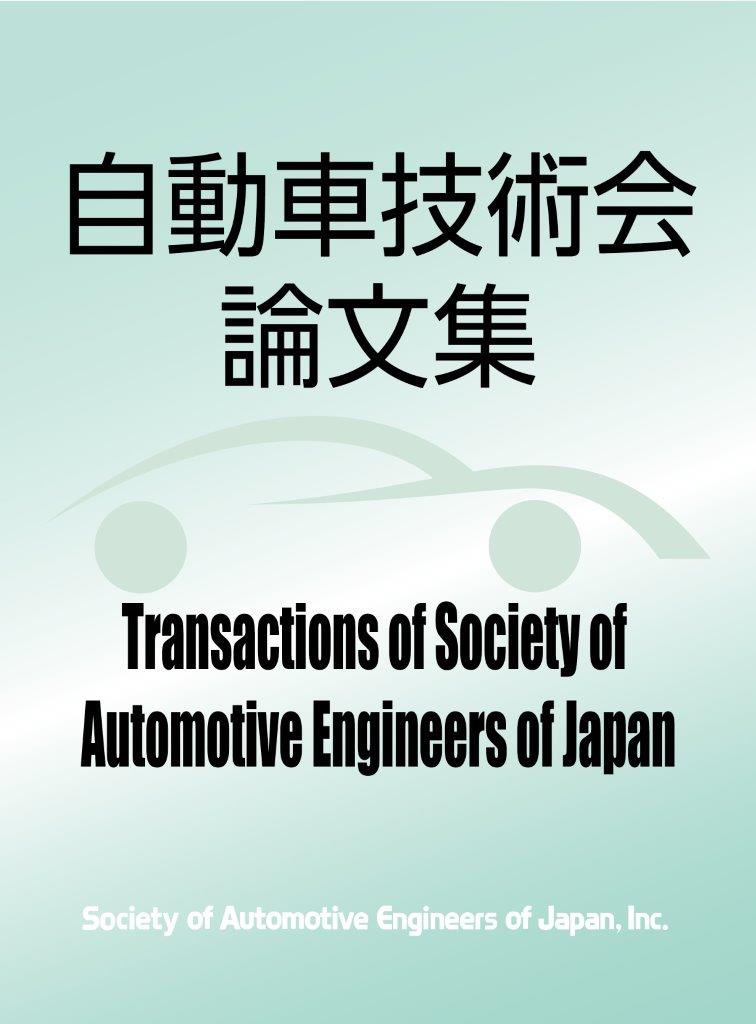Volume 53, Issue 6
Displaying 1-37 of 37 articles from this issue
- |<
- <
- 1
- >
- >|
Research Paper
-
2022 Volume 53 Issue 6 Pages 1021-1026
Published: 2022
Released on J-STAGE: October 11, 2022
Download PDF (1297K) -
2022 Volume 53 Issue 6 Pages 1027-1032
Published: 2022
Released on J-STAGE: October 11, 2022
Download PDF (1562K) -
2022 Volume 53 Issue 6 Pages 1033-1038
Published: 2022
Released on J-STAGE: October 11, 2022
Download PDF (1448K) -
2022 Volume 53 Issue 6 Pages 1039-1044
Published: 2022
Released on J-STAGE: October 11, 2022
Download PDF (2360K) -
Real Road Test Reproduction Method of Battery Electric Vehicles in the Chassis Dynamometer Test Cell2022 Volume 53 Issue 6 Pages 1045-1050
Published: 2022
Released on J-STAGE: October 11, 2022
Download PDF (1590K)
Technical Paper
-
2022 Volume 53 Issue 6 Pages 1051-1056
Published: 2022
Released on J-STAGE: October 11, 2022
Download PDF (1461K)
Research Paper
-
2022 Volume 53 Issue 6 Pages 1057-1062
Published: 2022
Released on J-STAGE: October 11, 2022
Download PDF (1372K) -
2022 Volume 53 Issue 6 Pages 1063-1068
Published: 2022
Released on J-STAGE: October 11, 2022
Download PDF (1364K) -
2022 Volume 53 Issue 6 Pages 1069-1075
Published: 2022
Released on J-STAGE: October 11, 2022
Download PDF (2933K) -
2022 Volume 53 Issue 6 Pages 1076-1080
Published: 2022
Released on J-STAGE: October 11, 2022
Download PDF (1706K) -
2022 Volume 53 Issue 6 Pages 1081-1087
Published: 2022
Released on J-STAGE: October 11, 2022
Download PDF (1206K) -
Velocity Estimation for Detected Objects in Wide Angle Monocular Vision of Multi-Shift Stereo Camera2022 Volume 53 Issue 6 Pages 1088-1094
Published: 2022
Released on J-STAGE: October 11, 2022
Download PDF (155K) -
2022 Volume 53 Issue 6 Pages 1095-1101
Published: 2022
Released on J-STAGE: October 11, 2022
Download PDF (1323K) -
2022 Volume 53 Issue 6 Pages 1102-1107
Published: 2022
Released on J-STAGE: October 11, 2022
Download PDF (5404K) -
2022 Volume 53 Issue 6 Pages 1108-1113
Published: 2022
Released on J-STAGE: October 11, 2022
Download PDF (1618K) -
2022 Volume 53 Issue 6 Pages 1114-1121
Published: 2022
Released on J-STAGE: October 11, 2022
Download PDF (1685K) -
2022 Volume 53 Issue 6 Pages 1122-1127
Published: 2022
Released on J-STAGE: October 11, 2022
Download PDF (2424K) -
2022 Volume 53 Issue 6 Pages 1128-1133
Published: 2022
Released on J-STAGE: October 11, 2022
Download PDF (1513K) -
2022 Volume 53 Issue 6 Pages 1134-1139
Published: 2022
Released on J-STAGE: October 11, 2022
Download PDF (1367K)
Technical Paper
-
2022 Volume 53 Issue 6 Pages 1140-1145
Published: 2022
Released on J-STAGE: October 11, 2022
Download PDF (2126K)
Research Paper
-
2022 Volume 53 Issue 6 Pages 1146-1153
Published: 2022
Released on J-STAGE: October 14, 2022
Download PDF (1519K) -
2022 Volume 53 Issue 6 Pages 1154-1159
Published: 2022
Released on J-STAGE: October 14, 2022
Download PDF (2733K) -
2022 Volume 53 Issue 6 Pages 1160-1165
Published: 2022
Released on J-STAGE: November 25, 2022
Download PDF (1442K) -
2022 Volume 53 Issue 6 Pages 1166-1171
Published: 2022
Released on J-STAGE: November 25, 2022
Download PDF (2302K) -
2022 Volume 53 Issue 6 Pages 1172-1177
Published: 2022
Released on J-STAGE: November 25, 2022
Download PDF (1800K) -
2022 Volume 53 Issue 6 Pages 1178-1185
Published: 2022
Released on J-STAGE: November 25, 2022
Download PDF (7244K)
Technical Paper
-
2022 Volume 53 Issue 6 Pages 1186-1191
Published: 2022
Released on J-STAGE: November 25, 2022
Download PDF (2063K)
Research Paper
-
2022 Volume 53 Issue 6 Pages 1192-1197
Published: 2022
Released on J-STAGE: November 25, 2022
Download PDF (1476K) -
2022 Volume 53 Issue 6 Pages 1198-1204
Published: 2022
Released on J-STAGE: November 25, 2022
Download PDF (3160K)
Technical Paper
-
2022 Volume 53 Issue 6 Pages 1205-1211
Published: 2022
Released on J-STAGE: November 25, 2022
Download PDF (2132K)
Research Paper
-
2022 Volume 53 Issue 6 Pages 1212-1218
Published: 2022
Released on J-STAGE: November 25, 2022
Download PDF (8336K) -
2022 Volume 53 Issue 6 Pages 1219-1226
Published: 2022
Released on J-STAGE: November 25, 2022
Download PDF (2160K) -
2022 Volume 53 Issue 6 Pages 1227-1232
Published: 2022
Released on J-STAGE: November 25, 2022
Download PDF (1617K) -
2022 Volume 53 Issue 6 Pages 1233-1238
Published: 2022
Released on J-STAGE: November 25, 2022
Download PDF (1086K) -
2022 Volume 53 Issue 6 Pages 1239-1246
Published: 2022
Released on J-STAGE: November 25, 2022
Download PDF (1872K) -
2022 Volume 53 Issue 6 Pages 1247-1252
Published: 2022
Released on J-STAGE: November 25, 2022
Download PDF (2429K) -
2022 Volume 53 Issue 6 Pages 1253-1259
Published: 2022
Released on J-STAGE: November 25, 2022
Download PDF (2996K)
- |<
- <
- 1
- >
- >|
